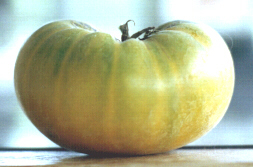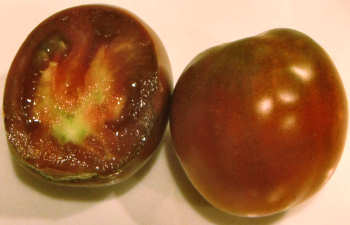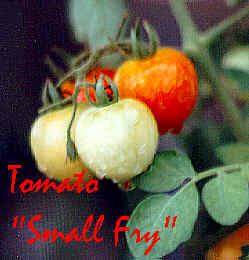Tomato Facts
Tomato Colors
Tomato colors are kind of tricky; red isn’t the only color in the pallet. If you’ve spent any time with seed catalogs or read any books on tomatoes, you’ll see references to yellow, pink, orange, bicolor, striped, green, purple, chocolate, white and black. And now the pallet includes blue/indigo!
Still, the colors aren’t necessarily obvious. Nor do the same varieties of tomatoes grown in different climates have the same color. What’s a home gardener to do?
Notes on Color
In general, tomato fruit colors are more vivid in warm climates than the cooler climates. While it doesn’t always hold true (many reds, pinks and yellows are bright no matter where), others need warmer weather to color up.
Conversely, tomatoes like the white varieties need cooler weather to retain most of their white/ivory color. Grown in the sunny South, they’ll end up more yellow.
The shades that really need warmth to reveal their depth of color are the purple, chocolate and black tomatoes. If you grow these in the cooler climates, you may be disappointed as to the paleness of the colors of the ripe fruits, compared to what you see online or in catalogs (which tend to be grown in warmer climates).
Tomato Colors
The fruit colors are as follows:
- Red: No real need to explain this, as it’s what you see in the grocery store. Red tomatoes have red interiors and yellow skin.
- Pink: These are tomatoes with a red interior but clear skin; therefore, they appear pinker than the reds.
- Purple: Generally a richer, dusky pink, both skin and flesh.
- White: I have yet to see a white tomato (in my climate anyway) that stays white when ripe. They start out that way, but then develop ivory to light yellow tones. The best chance for a white tomato to stay almost all white is one grown in a cooler climate, and shaded by a lot of leaves.
- Yellow: A clear, lemony yellow, both inside and out.
- Gold: These are the tomatoes that start out as yellow, but turn a richer gold color when ripe.
- Orange: These are really orange-colored, although some are brighter than others.
- Green: The skin is mostly green when ripe, with an amber blush on the blossom end. The interiors tend to be an almost neon green.
- Chocolate: A dusky purple. If you’re not used to darker tomatoes, you might think these look very strange when ripe.
- Black: A much darker purple. Some people are put off by the color of the skin and flesh of a black tomato, but they really are very good!
- Bicolor: Generally these refer to the red and yellow colors. The interiors are usually a swirl of yellow and red — gorgeous when cut in half!
- Striped: Just as you might imagine, the exterior is striped. The interior is usually just one color though. Visually stunning!
- Blue (Indigo): A relatively new color, but not exactly blue. They have a lot of anthocyanin in their skins, and they actually can look rather blue when unripe. Then the blue color turns more of a dark purple as they ripen.
Quite a few choices, wouldn’t you say? As a special note, the more exotic colors are generally heirloom tomatoes. Hybrids tend to be in the red-pink-yellow range, with some orange and white thrown in for good measure. Naturally, there are exceptions (there are quite a few indigo hybrids popping up).
Do the Different Colors Taste Different?
There are no hard-and-fast rules as to correlating tomato color to tomato taste; it really depends on the tomato variety and the growing conditions.
That being said, some people think that:
- Green tomatoes taste “zippier”.
- Yellow, white and orange tomatoes have the reputation of being blander (although not necessarily bland). But there are plenty of them that are very tomatoey tasting!
- Pink and purple tomatoes have the richest tastes and creamiest textures.
- Black and chocolate tomatoes have a deeper taste, less sweet.
- Bicolor and blue/indigo tomatoes are kind of all over the place. Most are just nice.
- Red tomatoes are the most common and range from bland (usually the store-bought ones) to very rich and luscious.
But like I said, it really does depend on the variety you grow. Not all tomatoes of a different color are alike!
Saving Tomato Seeds
Saving tomato seeds isn’t terribly difficult, although it can get a wee bit on the aromatic side. Here are some tips on how to save tomato seeds.
Know Your Tomato Variety
The first thing is you need to know if the tomato variety you want to save the seeds from is a hybrid or open-pollinated.
A hybrid is a cross between two different tomato varieties. Seeds grown from the hybrid may or may not be like the plant from which they came. (Most likely they will be different.) Don’t save seeds from hybrids unless you want to be surprised!
If your tomato variety is open-pollinated (which includes heirlooms), then the plants you grow from the seeds you save will be just like the parent plant.
Saving Tomato Seeds
Here are the steps for saving tomato seeds.
- Pick the best examples of your ripe tomatoes (choose three or more tomatoes from each variety of the plants).
- Slice the tomatoes in half and squeeze the tomato juice and seeds into a small plastic container. Put only one tomato variety in each cup.
- Add a tablespoon of water.
- Label the container with the name of the tomato variety.
- Cover the cups loosely with plastic wrap and set them in a warm location (between 75 and 80 degrees is best). If it’s warm enough, you may want to set the cups outside because the next step can get, um, aromatic (smelly).
- Let the container set for at least three days; you will see white scum appearing on top of the liquid in the container. This is normal. And a bit strong-smelling. This is the fermentation process.
If the temperature is warm (around 80), let the container sit for another 2 or 3 days after the fermentation starts; if it’s been cooler, you may need 4 or 5 days. Then you’re ready to clean the tomato seeds.
Cleaning and Collecting the Seeds
Here’s how to clean out the containers and get the seeds. (Hint: do this outside if you can.)
- Grab a pail and either a garden hose with a pistol-grip sprayer or several small bottles of water.
- Add some water to the container with the seeds and swish it around some. The good seeds will fall to the bottom; bad seeds will float to the top.
- Dump out as much liquid as you can, along with the bad seeds, then add some more water and swish again. Dump out the excess water.
- Repeat until the water is clear, which means the seeds are clean.
- Grab a paper towel and dump the seeds onto it, to absorb any extra moisture, then transfer to a paper plate.
- Spread the seeds around on the paper plate so they aren’t piled up; they need to air dry. Label the paper plate with the tomato variety name.
- Move around the seeds once a day to make sure all sides are sufficiently dried. They should be good after two or three days, unless you have the paper plate with seeds in a humid location. If that’s the case, give it a few extra days.
- Store the seeds in a paper envelope, small plastic bag or a small container with a lid. Label your container!
Place the seeds in a cool, dry place and they should last several years (although they are best used within 2 to 3 years if possible). However, I have seeds over 10 years old that are germinating fine, even as I write this. Still, the sooner you use (or share) the seeds, the more likely they are to germinate and thrive.
Tomato Growth Requirements
It’s time to learn about tomato growth requirements — what they like, in order to grow best. While individual varieties may be better for warmer or cooler climates than you average tomato, you still need to know the basics.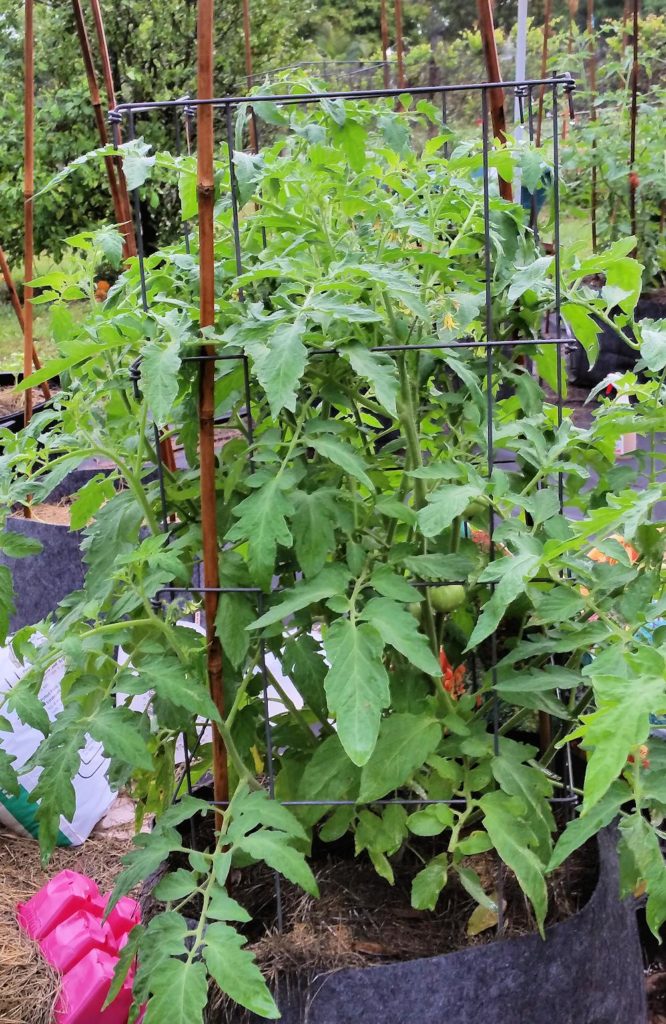
With that thought in mind, here are the basic requirements for growing tomatoes.
Tomato Growth Requirements
Like most fruits and vegetables, tomatoes require at least 6 hours or direct sunlight a day. If you live in a super-sunny and hot location, your tomato plants might appreciate some dappled shade in the afternoons, to help prevent against both wilting and sunscald.
Tomatoes also require warm weather — frost will kill them. The ideal temperatures for most (not all!) tomatoes is the mid 70’s to low 80’s during the day, with nights in the mid 50s to mid 60’s. (Temperatures in degrees Fahrenheit.)
In an ideal climate, there should be a 15 to 20 degree difference between day and night temperatures. However, when the nighttime lows are routinely in the 70s, the plants might not get enough of a cool-down to set fruits well.
However, tomatoes will grow and set fruit in warmer weather, as well as in cooler weather; they just won’t be quite as productive. Keep your local temperatures in mind when selecting tomato varieties.
For example, a grower in the cool Pacific Northwest would be better off with early tomatoes (those that mature in 67 days or less), as well as tomatoes that are bred for cooler weather. On the other hand, someone in the desert Southwest would be well-advised to select tomatoes that have a good track record of bearing fruit in hot weather.
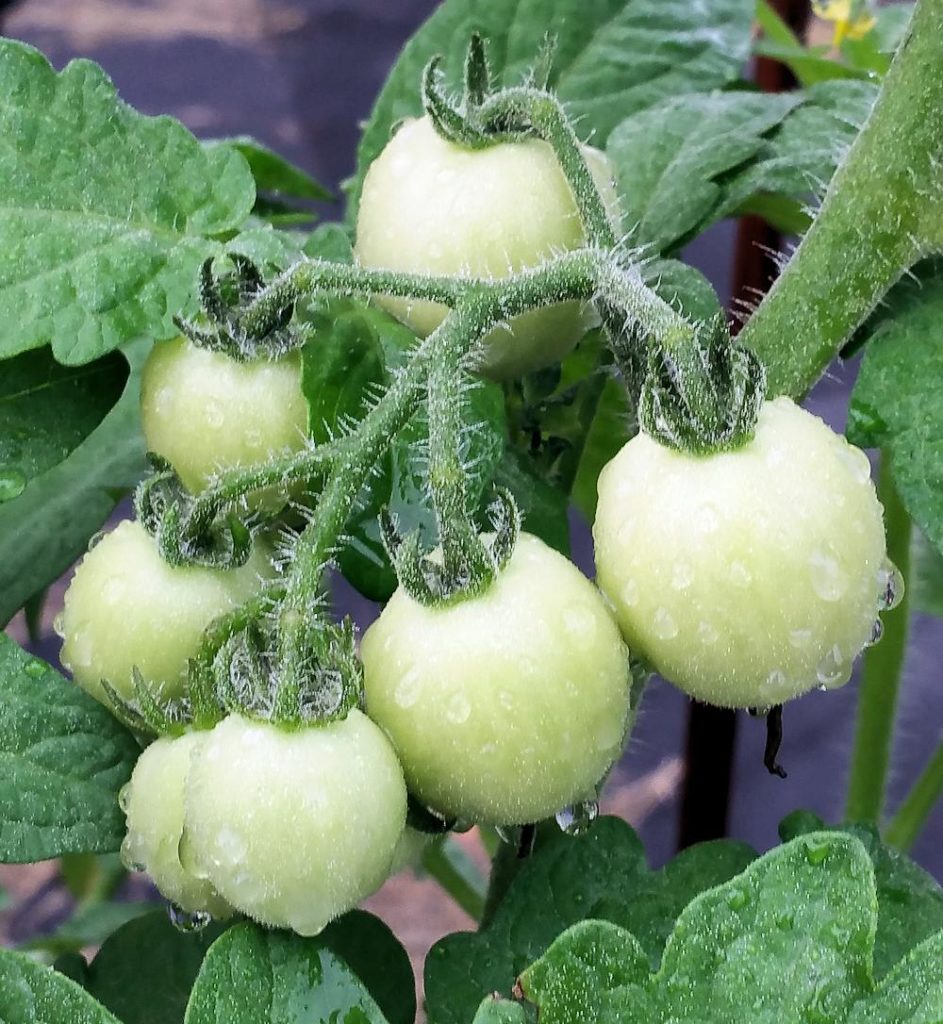 So, keep your local climate in mind when selecting tomato varieties. Oh, and an adequate water supply is essential for tomatoes to produce fruits; an average of an inch of water per week is considered optimal, but if you live in a dry climate, you might want to provide a bit more; tomatoes can get thirsty!
So, keep your local climate in mind when selecting tomato varieties. Oh, and an adequate water supply is essential for tomatoes to produce fruits; an average of an inch of water per week is considered optimal, but if you live in a dry climate, you might want to provide a bit more; tomatoes can get thirsty!
And if you live in a hot and humid climate, like the Southeast — be especially careful with your fertilizing schedule, and know the tomato diseases that thrive in a hot, humid environment.
Tomato Growing Questions
Ok, tomato fun facts aside, you may have some additional tomato growing questions. Here are a few of the most common questions, with links to more detailed answers.
Before we go on to the growing questions, though, here’s a question that has plagued people for years: are tomatoes fruits or vegetables?
Botanically, tomatoes are fruits; however, as far as use, tomatoes are classed as vegetables. How come? At one point, the US government was levying a tax on imported vegetables, and tomatoes became an issue — fruit or vegetable? The final decree was “If it’s most often eaten as a part of a meal (salad or mail course), it’s a vegetable. If it’s most often eaten as a dessert, its a fruit.”
Tomato Growing Questions
Are tomatoes easy to grow? For the most part, yes! Most tomato varieties will grow and produce delicious fruits for you. If you have a short gro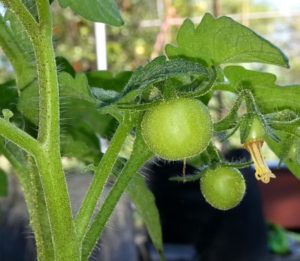 wing season or lots of cloudy days, however, you should stick with the early and possibly mid season fruits (stay away from the huge beefsteaks — they won’t have time to ripen). If you have a longer growing season with plenty of sunshine, you can grow almost any variety. Caveat; most tomatoes don’t like really hot and humid weather (although some varieties do OK in the heat & humidity).
wing season or lots of cloudy days, however, you should stick with the early and possibly mid season fruits (stay away from the huge beefsteaks — they won’t have time to ripen). If you have a longer growing season with plenty of sunshine, you can grow almost any variety. Caveat; most tomatoes don’t like really hot and humid weather (although some varieties do OK in the heat & humidity).
So how do I grow tomatoes? Here’s some tomato growing requirements on how to grow those great-tasting tomatoes!
Should I get plants from a garden center or start from seeds? This one will depend on your circumstances. If you are late for starting seeds, or you just don’t want to go the seed route, buying a plant from a gardening center is great. Just keep in mind that there usually isn’t a huge variety, although mostly they are varieties that will grow fine in your area. When it comes to seeds, the sky is the limit! You can grow all kinds, and experimenting can be fun. It’s also less expensive overall than buying plants. (I’ve had tomato seeds 5 and even 10 years old and still germinate.)
What kind of insects or diseases do I need to know about? Here is the lowdown on insects and diseases that could come to visit your tomatoes — and possible solutions!!
What kind of fertilizer should I use? You can use organic, chemical or a mixture of both. Check out the tomato fertilizer page for information about the different kinds.
Can I grow tomatoes is a greenhouse? Sure! The key to deciding the varieties that would be best are 1) the size of your greenhouse and 2) the warmth and sunlight your greenhouse receives. Your best bets may be determinate tomatoes, cherry tomatoes, and heart-shaped tomatoes (but any kinds are possible, depending on how big your greenhouse is).
When should I plant tomatoes? It really depends on your climate! For example, in South Florida, early Fall, late Winter and Spring are our prime tomato-growing times. For most of the country, Summer is the prime growing season. Here’s a general rule of thumb; start your seeds indoors at 4 to 6 weeks before your last expected frost — then transplant to the garden 1 week after the last expected frost (you can go a little earlier with protection).
It’s Fall, frost is coming, and my plants still have unripe tomatoes! Can I ripen these tomatoes indoors? You’ll probably be able to ripen some to even most of your tomatoes that are still on the vine; here are some tips. If you have the space, you can pull up the entire tomato plant(s) and hang them upside-down in a cool dark place. As the tomatoes ripen, pull them off the vine and enjoy! If you don’t have that kind of space, pluck the tomatoes that are farthest along, and wrap them loosely in some newspaper. Store the tomatoes in a cool dark place, in a single layer. Check the tomatoes periodically, and use those that are ripe.
Got more questions? Check out the tomato growing terms page!
Tomato Fun Facts
There are a lot of tomato questions, apart from how to actually grow them. This is more of a fun facts page, where you find out what you didn’t know that you didn’t know about tomatoes!
Tomato Fun Facts
Where Did Tomatoes Come From? The tomato is a New World addition to the diet, originating in South America in the Andes region (Chile, Ecuador, Peru). It was Central American Indians who are thought to be the first to domesticate the tomato. Tomatoes were introduced into the European diet by explorers from Mexico, in the 1500’s. Interestingly, the initial tomatoes brought back to Europe appear to have been yellow, or golden, in color — not the red that is so familiar today.
Are Tomatoes Good for You? Fresh tomatoes are loaded with Vitamins A and C. Not to mention it’s pretty much the best natural source for the antioxidant lycopene.
What Colors do Tomatoes Come In? Just about any color! There are black, white, purple, pink, orange, yellow, red, chocolate and bicolor. Blue tomatoes are now on the scene, and there are even tomatoes that stay green when they are fully ripe! And let’s not forget about the striped tomatoes — oh my!
What Shapes Do Tomatoes Come In? You’re familiar with the round and oval tomato shapes. But some others include heart-shaped, long sausage-shaped, pear-shaped and even square-shaped (okay, kind of a rounded square, but squarish nonetheless).
Which is Better – Determinate or Indeterminate? It depends on what you want to do with the tomatoes! For example, if you plan to eat some of the tomatoes fresh, but you want to preserve/can the rest, a determinate plant might be your best bet. Since it sets all its fruit at the same time, it helps streamline the canning process. If, however, you want a few tomatoes this week, a few next week, etc., an indeterminate plant might be your choice. Your ripe tomatoes are spread out over a several week period. But why not have at least one of each type, to provide constant fresh tomatoes for a variety of uses?
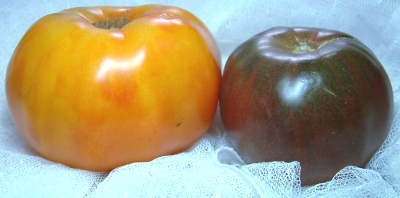 What Sizes do Tomatoes Come In? The most common size the average gardener will grow is roughly 5 to 8 ounces. The tiniest I’ve ever seen were the about the size of an 8-mm bead; a fraction of an ounce. The largest tomatoes that the average gardener will grow is about 2 pounds (now that’s a LOT of tomato sandwiches)!
What Sizes do Tomatoes Come In? The most common size the average gardener will grow is roughly 5 to 8 ounces. The tiniest I’ve ever seen were the about the size of an 8-mm bead; a fraction of an ounce. The largest tomatoes that the average gardener will grow is about 2 pounds (now that’s a LOT of tomato sandwiches)!
Is it True That Tomatoes and Peppers are Related? Sure! Tomatoes and peppers are both part of the Solanaceae family, along with eggplants, tomatillos and potatoes! The tomato’s scientific name is Lycopersicon esculentum, which translates to “edible wolf-peach”. (With a name like that, no wonder the tomato was shunned as a food for many years!)
What’s the Difference Between Heirloom and Open Pollinated Tomatoes? Heirloom tomatoes are those varieties that have been around for at least since 1950, and they breed true from seed. In other words, if you save the seeds from a ripe heirloom tomato, you are likely to get a tomato that’s just like the parent. An open pollinated tomato is very similar; it just hasn’t been around as long as an heirloom. Keep this in mind — all heirlooms are open-pollinated (they breed true to seed) but not all open-pollinated tomatoes are heirloom.
What’s a Hybrid Tomato? A hybrid tomato, on the other hand, does not breed true. Since it is a deliberate cross between two different tomato plants, hybrids can produce seeds that when planted, can become more like the “grandparents” (which may or may not be a good thing!). Many times you will see “F1” after a tomato name; that is a tip-off that the tomato is a hybrid.
Why are Hybrid Seeds and Plants More Expensive? To get the hybrid seeds, suppliers must plant two different kinds of tomatoes and cross them to get the hybrid seeds. In most cases, the parent tomatoes are “trade secrets”. It’s also expensive to hand-pollinate the tomato blossoms, to assure the correct cross is made, or grow them in greenhouses, segregated spaces, etc. All this adds to the price of hybrid seeds.
What Kind is Best? It depends on what you want! In general, although vine-ripened hybrid tomatoes grown at home taste much better than their anemic cousins sold at the grocery store, it’s the heirloom and open-pollinated tomatoes that usually win the taste-tests. In addition, if you want to grow your plants organically (or at least with minimal chemical fertilizers), heirloom tomatoes have the tendency to do better. Here’s the caveat; hybrid tomatoes generally have greater disease-resistance than do heirloom. A compromise is sometimes the open-pollinated, which often have more disease-resistance, yet still have a great taste. (I grow and eat all three kinds, although I tend to grow more heirloom than anything else.) What it boils down to is what is most important to you, and how you plan to use the tomatoes.
How Many Different Kinds of Tomato Varieties are Available? In a word – lots! The Seed Savers Exchange (SSE), located in Decorah, Iowa, lists close to 2,000 tomatoes in its yearbook. However, the SSE catalogs just heirloom and open-pollinated tomatoes; don’t forget that there are still hundreds (if not more) of hybrid varieties. There are estimates that close to 10,000 varieties may exist in the world today.
How Long Will a Tomato Plant Live? Alas, tomato plants live only a season. When the frost comes, the tomato plants die. In mild regions, tomato plants can live a bit longer, but they do eventually die. Consider then annuals.
Where Can I Get Different Kinds of Tomatoes? Why not grow your own? They’re fun to grow, and you can be sure they’re vine-ripened and fresh. Also, growing your own tomatoes allows you to grow the varieties that you like — not what the grocery store buyer thinks you should like. You can buy a plant at a gardening center or better yet — grow your own from seeds. Anyway you can get them, once you’ve eaten homegrown tomatoes, no grocery store tomato will ever measure up.
